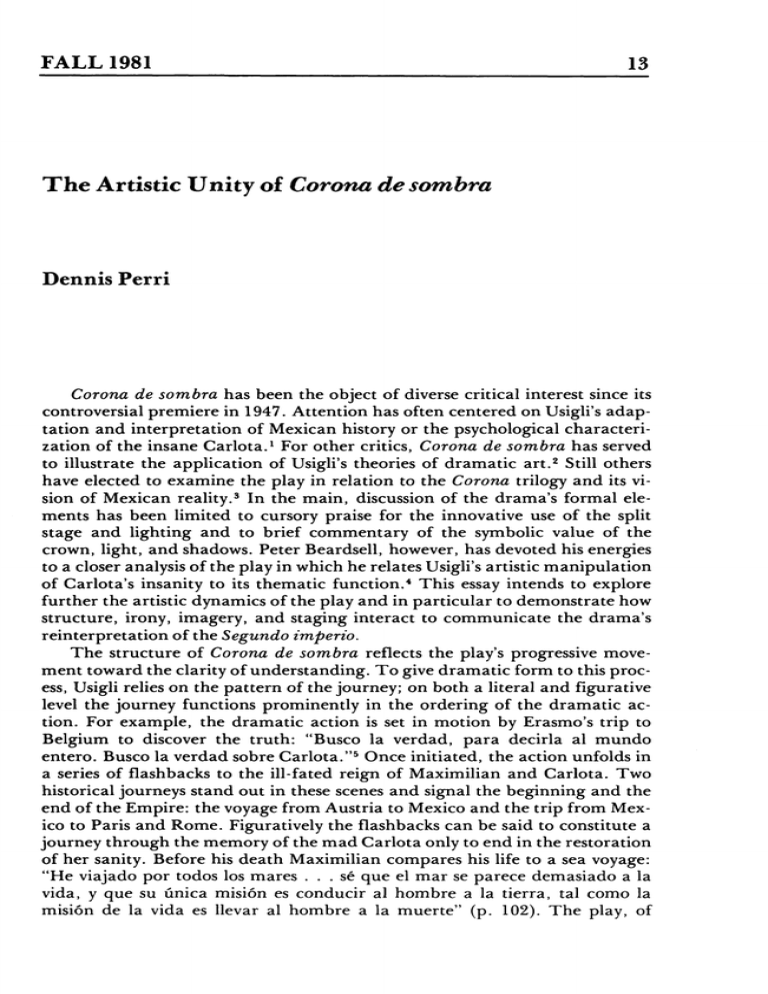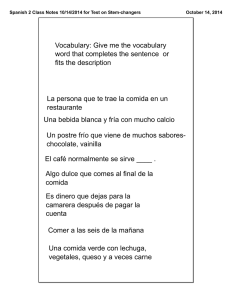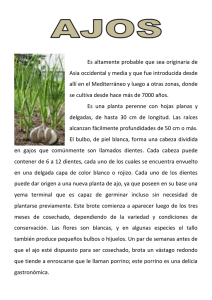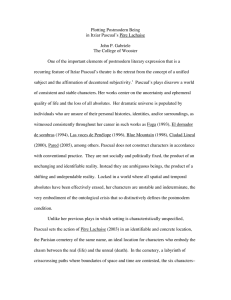The Artistic Unity of Corona de sombra
Anuncio

FALL 1981 13 The Artistic Unity of Corona de sombra Dennis Perri Corona de sombra has been the object of diverse critical interest since its controversial premiere in 1947. Attention has often centered on Usigli's adaptation and interpretation of Mexican history or the psychological characterization of the insane Carlota. 1 For other critics, Corona de sombra has served to illustrate the application of Usigli's theories of dramatic art. 2 Still others have elected to examine the play in relation to the Corona trilogy and its vision of Mexican reality.3 In the main, discussion of the drama's formal elements has been limited to cursory praise for the innovative use of the split stage and lighting and to brief commentary of the symbolic value of the crown, light, and shadows. Peter Beardsell, however, has devoted his energies to a closer analysis of the play in which he relates Usigli's artistic manipulation of Carlota's insanity to its thematic function. 4 This essay intends to explore further the artistic dynamics of the play and in particular to demonstrate how structure, irony, imagery, and staging interact to communicate the drama's reinterpretation of the Segundo imperio. The structure of Corona de sombra reflects the play's progressive movement toward the clarity of understanding. To give dramatic form to this process, Usigli relies on the pattern of the journey; on both a literal and figurative level the journey functions prominently in the ordering of the dramatic action. For example, the dramatic action is set in motion by Erasmo's trip to Belgium to discover the truth: "Busco la verdad, para decirla al mundo entero. Busco la verdad sobre Carlota."5 Once initiated, the action unfolds in a series of flashbacks to the ill-fated reign of Maximilian and Carlota. Two historical journeys stand out in these scenes and signal the beginning and the end of the Empire: the voyage from Austria to Mexico and the trip from Mexico to Paris and Rome. Figuratively the flashbacks can be said to constitute a journey through the memory of the mad Carlota only to end in the restoration of her sanity. Before his death Maximilian compares his life to a sea voyage: "He viajado por todos los mares . . . sé que el mar se parece demasiado a la vida, y que su única misión es conducir al hombre a la tierra, tal como la misión de la vida es llevar al hombre a la muerte" (p. 102). The play, of 14 LATIN AMERICAN THEATRE REVIEW course, serves to chronicle significant moments in this voyage. Simply stated, whether conceived in temporal, spatial, or metaphorical terms, the journey governs the general organization of the drama and is well-suited to its central action: the gradual advance toward awareness. The journeys of the characters reveal as well an interdependence which links the historical and psychological dimensions of the drama. Dissatisfied with traditional interpretations of the Segundo imperio, the historian Erasmo must travel with Carlota through her memory: "Quizás en lo que diga habrá algo, algo que me ayude en mi trabajo" (p. 35). Due to the historian's stimulus, Carlota, in turn, initiates a process through which she ultimately recovers her sanity: "Siento como si de pronto pudiera yo comprender todas las cosas" (p. 95). Ironically, Carlota's original trips to Mexico and then to Europe led to her loss of reason, but now when retold to Erasmo these trips result in the restoration of her reason. Carlota's return to the past occasions the reenactment of Maximilian's tragic journey whose end ultimately proves to complete that of Carlota and Erasmo. Awaiting his execution Maximilian sees clearly his role in the history of the Mexican nation: "Muero con la conciencia tranquila, porque no fue la simple ambición de poder la que me trajo aquí, ni pesa sobre mí la sombra de un solo crimen deliberado. En mis peores momentos respeté e hice respetar la integridad de México" (pp. 105-6). T h e historian has discovered the object of his journey: "Ahora lo veo claramente . . . México consumó su independencia en 1867 gracias a él" (p. 107). Maximilian protected Mexico from the real threat to its sovereignty, namely, Napoleon. Carlota has likewise completed her journey: "Siento en mí una paz profunda, la luz que me faltaba" (p. 107). The journey not only gives form to the drama's action, but it is also visible in scenic construction. Numerous scenes occur during situations of arrivals and departures: Act I, scene ii, eve of the departure for Mexico; scene iii, arrival in Mexico; Act II, scene ii, eve of Carlota's departure for Europe; scene iii, arrival in Paris; scene iv, arrival in Rome. Departures and arrivals normally suggest moments of anticipation and apprehension. The atmosphere of heightened tension generates a sense of imminent action. Situations of departure and arrival, moreover, provide a logical setting for the characters to explain past motivations, to anticipate future actions, and to initiate action toward their goals. This interrelationship between past and present, cause and effect, is what Erasmo and Carlota must comprehend in order to arrive at their respective destinations. Finally, the speeches of the characters reinforce the motif of a journey through the repeated references to sea, ship, and trips. For instance, Maximilian can be heard to remark: "He pensado que podríamos emprender viajes, ahora que hay nuevas rutas, nuevos medios de transporte" (p. 27); " T ú tienes que preparar tu viaje" (p. 65); "He viajado por todos los mares" (p. 102); "el mar se parece demasiado a la vida" (p. 102); "Cuando pienso en la cabalgata loca que han sido estos tres años del imperio . . ." (p. 103). T h e mention of boats and trips pervades the speeches of Carlota: "Ese viaje tan largo . . ." (p. 20); "Debo quitarme este horrible traje de viaje" (p. 20); "por eso he callado durante todo el viaje" (p. 23); "Lo descubrí al hacer el viaje de regreso" (p. 23); "Ese barco tan largo" (p. 24); "un camino tan largo" (p. 24); FALL 1981 15 "Largo. Un viaje largo" (p. 66); "Ese viaje interminable puso a prueba mis nervios" (p. 69); "Pero no podía yo llegar al otro extremo del barco" (p. 76); "¿Cómo podría llegar al otro extremo del barco?" (p. 77); "Este barco tan largo" (p. 81). In sum, structure, dramatic situation, and language all converge around the concept of the journey, a journey whose end is not a spatial point, but a state of understanding. Irony complements the formal function of the journey by reminding the audience of the overall pattern even within individual scenes. Or in William Empson's words: "irony . . . offers an intelligible way of reminding the audience of the rest of the play when reading or seeing a single part of it." 6 One example of irony in Corona de sombra will illustrate its dramatic function and reinforcement of the pattern of journey. In Act II Carlota icily recommends that Juárez be murdered: "Lo destruiremos, te lo juro. . . . Mandaremos a alguien que acabe con él . . . ¿Qué es un asesinato político para salvar un imperio?" (p. 54). Her solution is ironic since it is Juárez who will have Maximilian executed and also since her obsessive thirst for power will drive her insane. As a result the irony increases the dramatic tension of her speech and reminds the audience that Carlota's journey leads toward punishment and grief. Yet the desire for Juarez's blood is ironic in another sense for it is expressed after the audience has heard Carlota remark to Erasmo (believing him to be Juárez): "Y me pareció desde entonces que os odiaba. Pero os veo aquí, frente a mí, y sé que no es verdad. Yo no os odio . . . Pero vos me inspiráis confianza" (p. 25). Thus, there is the suggestion that her journey will also bring about insight. The irony of this moment (the call for assassination) encourages the audience to evaluate Carlota's actions and attitudes as parts of a continuum or journey which on one level points to suffering and on another to a possibly clearer understanding of reality. Imagery effectively punctuates relevant stages in the characters' unfolding journeys. To be specific, the changing images of the forest, sun, and crown underscore the movement of the characters toward their destination. T h e first mention of the Chapultepec forest describes it as a mysterious, fascinating haven for two lovers. "El bosque me tiene fascinado. Chapultepec, lugar de chapulines. . . . Escapemos del imperio . . . Como dos prometidos o como dos amantes. Vayamos a caminar por el bosque azteca cogidos de la m a n o " (p. 40). At the outset of their reign, this retreat from the duties of imperial rule symbolizes their illusory dreams for Mexico. Even the couple's conflicting attitudes toward Juárez cannot interfere: CARLOTA —¿Para qué? Has roto el encanto. Yo pienso en ti y tú piensas en Juárez. MAXIMILIANO —No podemos separarnos así, amor mío. Vamos, te lo ruego. (Le besa la mano; luego la rodea por la cintura con un brazo. Ella apoya su cabeza en el hombro de él. . . Salen.) (p. 41) During Act Two the cloud of politics and violence casts a shadow over the forest and impedes access to it: MAXIMILIANO —Pero me siento inerte, perdido en un bosque de voces que me dan vértigo. (p. 62) 16 LATIN AMERICAN THEATRE REVIEW MAXIMILIANO — Una cita en el bosque mientras el imperio arde. CARLOTA —Eso es, Max: Una cita en el bosque, dentro de muy poco tiempo. Ahora hay que luchar, eso es todo —y hay que desconfiar— hay que matar. (pp. 54-55) Later, the forest appears as a sign of Carlota's delusions as she unrealistically anticipates a fruitful embassy to Paris and Rome: "volvemos a estar tan cerca como al principio, mi amor. . . . Nos veremos en el bosque, Max, pero a mi regreso. Sólo entonces podremos volver a ser nosotros mismos" (pp. 64-65). These are Carlota's last words to Maximilian and with an ironic twist they are prophetic. It is not a triumphant return from Europe, but an anguished return from 61 years of insanity which occasions the couple's reunion in the forest. Furthermore, they will not meet in the dream-like forest of Chapultepec, but in the final haven, death. Nevertheless, a peaceful resignation marks Carlota's entry into this forest: (Carlota mira al frente. Sonríe. Se reclina en el respaldo del sillón con un gran suspiro de alivio.) CARLOTA —En el bosque, Max. Ya estamos en el bosque, (p. 108) Maximilian has already foreseen this last reunion: "Hasta muy pronto Carla. Hasta muy pronto en el bosque" (p. 105). T h e forest has come to signify the definitive destination of life's journey, but it is a death which holds meaning and consolation for both Maximilian and Carlota. Once Carlota faces the truth that her dreams have been destroyed and have caused destruction, she will reach the final stages of her journey. It is the evolving image of the sun which lends a lyric intensity to the progress of her journey. T h e sun can shed light and it can dazzle and blind. Both these traits and others are applied to Carlota's journey. Initially it is the sun which conveys the illusions of her youth: "deseé que el príncipe que me desposara se pareciera al sol como tú" (p. 31). For a brief moment, her personal fantasies and reality seem to converge in harmony as she contemplates her future in the land of the sun: "creen en el sol de la sangre y del rango . . . Es el país del sol y tú te pareces al sol. . . . ¿Tú crees que pueden odiar el sol en parte alguna?" (pp. 31, 32). The image of the sun only compounds the irony since it is not the light of truth that Carlota observes, but the bedazzling brilliance of personal fortune. Foolishly she believes that the splendor of a European monarchy can outshine the Aztec sun of Mexico's origins. Subsequent references to the sun produce ever increasing negative overtones. Once in Mexico, Carlota employs the image of the sun to accentuate the jealousy she feels, "Todas te miraban y te deseaban como el sol" (p. 39). This image foreshadows the obstacles Carlota will face in her selfish efforts to enjoy the sun of absolute power. In the stormy encounter with Napoleon, the frivolous Empress Eugenia declares: "La Emperatriz de México será el sol de nuestro baile" (p. 68). In the future Carlota had planned for herself, this image would have represented the attainment of her loftiest aspirations: power, respect, beauty. Instead the image strikes a bitterly ironic chord. On the verge of mental collapse and wildly clawing to save a crumbling empire, she must listen to platitudes from a woman she despises. Pius XI emphasizes the temporal dimension of the solar image to affirm FALL 1981 17 the finite nature of man, "El hombre es una sombra por la que pasan brevemente la sangre y el sol de la vida" (pp. 76-77). T h e sun signals the passing of time and fittingly appears at the point in which the sun of Carlota's obsessive ambition sets, to be replaced by 61 years of shadows. As will be discussed below, the sun of clarity will finally shine on Carlota in the form of theatrical lighting rather than linguistic imagery. The recurrent image of the crown best reflects the effect on Carlota of the journey toward knowledge. T h e young Carlota considers the Mexican opportunity to be an adventure and a dream transformed into reality. Her state of euphoria prompts the usually idealistic Maximilian to warn her pragmatically: "Pero no será una corona de juego" (p. 31). Previous statements by the Empress prove that she quickly learns the seriousness of the game and totally dedicates herself to the political struggle. At this point, Pius XI underscores Carlota's misguided faith in a temporal crown: "Dios da su corona a los buenos y es una corona más bella que la corona imperial . . . las coronas son de humo" (pp. 76-77). Unable to deal with the ephemeral nature of power and the actual loss of her crown, Carlota loses her mind. Deprived of her worldly crown and undeserving of a heavenly one, she must wear one of suffering and punishment, "su corona es de espinas y de sombra" (p. 82). Carlota herself recognizes the punishment in Act Three and her use of the crown image underlines the torture of its weight: "¿Y no bastan acaso sesenta años de vivir en la noche, en la muerte, con esta corona de pesadilla en la frente, para merecer el perdón?" (p. 99). T h e image of the crown at last reflects Carlota's insight, and to some degree her salvation, once she realizes that her suffering has served a purpose: "Lo que quiero deciros es que Maximiliano volvería a morir por México, y que yo volvería a llevar esta corona de sombra sobre mi frente durante sesenta años para oír otra vez vuestras palabras. Para repetírselas al Emperador" (p. 108). 7 In sum, the image of the crown has mirrored Carlota's development from being a blind, self-centered woman to an individual who has reached a deeper understanding of self and the events she helped shape. Not only the linguistic images but the theatrical devices as well reinforce the pattern of the journey. T h e divided stage and the action which shifts from side to side visually represent the drama's movement through time and space. Thus, the abstract concept of a journey becomes actualized through the staging. At the outset of the play the glass wall between the two portions of the stage serves to separate, while at the play's end this "división de cristales" becomes a symbol of insight as it offers the final proof that Carlota has indeed been insane for 61 years: "Carlota se acerca lentamente y trata de mirarse en los cristales; vuelve la vista a todas partes, toma un candelabro, y se acerca nuevamente a la vidriera, donde mira atentamente su reflejo" (p. 95). T h e verbal imagery concerning the sun has already been traced, but it is sunlight (stagelight) which frames the action of the entire play. Before the appearance of the characters the audience observes the set bathed in light: "Es de m a ñ a n a y la luz del sol penetra tumultuosamente por el balcón y la terraza" (p. 11). T h e majority of the play takes place during night scenes or with the sunlight blocked by curtains. At the completion of the characters' journeys, the audience again sees full sunlight: "Entonces, sin una palabra, LATIN AMERICAN THEATRE REVIEW 18 sopla una por una las bujías, se dirige al fondo y descorre las cortinas. La luz del sol penetra en una prodigiosa cascada, hasta iluminar la figura inmóvil de Carlota" (p. 109). T h e everpresent candelabra in Corona de sombra acts as a symbol of sight and blindness which accentuates the paradoxical nature of the journey through the memories of the m a d Carlota. Carlota's compulsion to substitute artificial for natural light graphically displays the depths of her madness, and nowhere is this madness more striking than in Act III, scene iii: "Se reconcentraba mirando al vacío. La luz de las doce bujías forma un círculo fantástico en torno a su rostro" (p. 95). T h e candelabra also announces the shift from one side to another of the divided stage. In these cases the candelabra figuratively illuminates the flashback scenes which in turn contribute to the characters' final awareness. Likewise it is the candlelight which assists Carlota to see that she has aged. It is the candelabra, then, that links the two dimensions of the journey through Carlota's memory. On the one hand the events as they occurred resulted in her loss of reason; on the other h a n d the recalling of them leads to sanity as Carlota and Erasmo form a more lucid perception of historical events and their significance. In conclusion, Corona de sombra is a unified work which dramatizes the reassessment of the Segundo imperio.8 Usigli creates a play in which structure, irony, imagery, and staging combine to involve the audience in this reinterpret ation of history. As we have seen, the interaction of these formal elements encourages the audience to consider the divergent and sometimes paradoxical forces which determine events and their significance. T h e death of Rodolfo Usigli is cause for a serious reexamination of the richness of his theatre. Corona de sombra is certainly a notable example of Usigli's dramatic art. Grinnell College Notes 1. For a m o r e detailed discussion of such topics see: J o h n B. Nomland, Teatro mexicano contemporáneo: 1900-1950, T r . Paloma Gorostiza de Zozaya and Luis Reyes de la Maza (México: Instituto Nacional de Bellas Artes, D e p a r t a m e n t o de Literatura, 1965); Ályce de Kuehne, Teatro mexicano contemporáneo; 1940-1962 (Mexico: Imprenta Benjamín Franklin, 1962); Francisco Monterde, "Juárez, Maximiliano y Carlota en las obras de los d r a m a t u r g o s mexicanos," Cuadernos Americanos, C X X X V I (September-October, 1964), 231-240; Gordon Ragle, "Rodolfo Usigli and his Mexican Scene," Hispânia, X L V I ( 1 9 6 3 ) , 307-311. 2. Consult: Solomon H . Tilles, "Rodolfo Usigli's Concept of Dramatic Art," Latin American Theatre Review, 3/2 (Spring, 1970), 31-38; Vera F. Beck, "La fuerza motriz en la obra d r a m á t i c a de Rodolfo Usigli," Revista Iberoamericana, XVIII (September, 1953), 369-383; Eunice J. Gates, "Usigli as Seen in His Prefaces and Epilogues," Hispânia, X X X V I I (December, 1954), 432-439. 3. See: Roberto R. Rodríguez, "La función de la imaginación en las Coronas de Rodolfo Usigli," Latin American Theatre Review, 10/2 (Spring, 1977), 37-44 and the introduction to Rodolfo Usigli, Two Plays: Crown of Light, One of these Days, trans. T h o m a s Bledsoe, ed. J. Cary Davis, introduction Willis K n a p p Jones (Carbondale: Southern Illinois University Press, 1966), xix-xxi. 4. Peter R. Beardsell, "Insanity and Poetic Justice in Usigli's Corona de sombra," Latin American Theatre Review, 10/1 (Fall 1976), 5-14. 5. Rodolfo Usigli, Corona de sombra, ed Rex Edward Ballinger (New York: AppletonCentury-Crofts, Inc., 1961), 22. All further quotation from the play will be taken from this edition. Future citations will include page references and will be incorporated into the text. 6. Bert O . States, Irony and Drama: A Poetics (Ithaca: Cornell University Press, 1971), p . 28. FALL 1981 19 7. Beardsell, "Insanity and Poetic Justice . . .," has also noted this interpretation of the "corona de espinas," when he states that it might, "suggest not only mockery and suffering but also the notion of sacrifice. It is possible to see Carlota, therefore, as a sacrificial victim, who wears her crown on behalf of Mexico, as Christ wore his on behalf of m a n " (p. 10). 8. I cannot agree with Alyce de Kuehne's j u d g m e n t of the drama's unity, as she claims Corona de sombra to be "una pieza de indiscutibles méritos, cuya falta de u n i d a d se achaca a u n a caprichosa estructura cinematográfica." Teatro mexicano contemporáneo: 1940-1962, p . 65.





